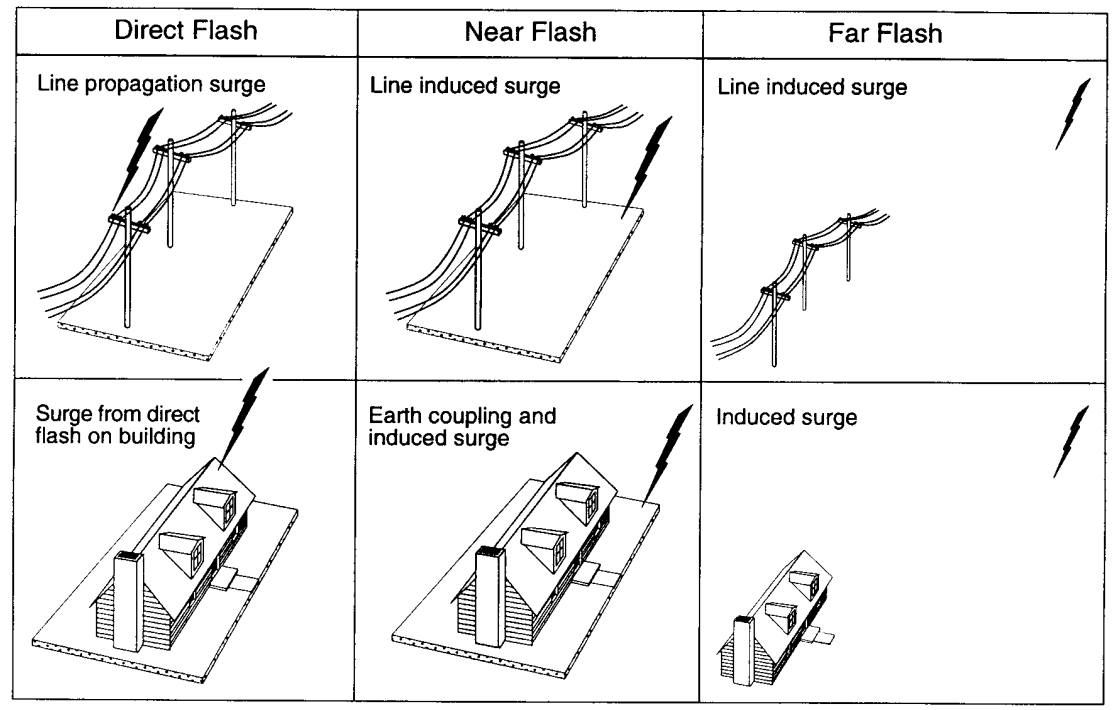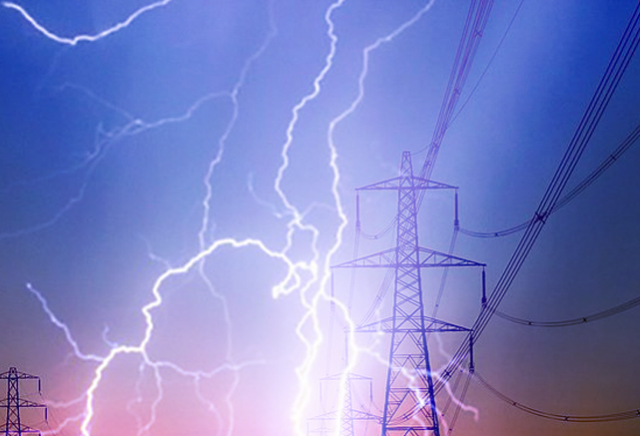I. Causes
Surge voltages and surge currents occurring in low-voltage ac power circuits can be caused by:
- Lightning surges.
Lightning surges are the result of a direct flash to the power system, to the structure of interest and nearby structures, or to the soil. Distant lightning flashes can also induce voltage surges in the circuits of an installation.Lightning is a natural and unavoidable event that affects low voltage power systems as well as signal and communication systems through several mechanisms. The obvious effect is a direct flash to the power system or to the building of interest, but other coupling mechanisms into overhead or buried power circuits can also produce overvoltages and associated surge currents.
- Switching surges.
Switching surges are the result of intentional actions on the power system, such as load or capacitor switching. They can also be the result of unintentional events, such as power system faults and the subsequent corrective actions.Generally, any switching operation, fault initiation, interruption, etc. in an electrical installation is followed by a transient phenomenon in which overvoltages can occur. The sudden change in the system can initiate damped oscillations with high frequencies determined by the resonant frequencies of the network, until the system is again stabilized to its new steady state. The magnitude of the switching overvoltages depends on many parameters, such as the type of circuit, the kind of switching operation (closing, opening, restriking), the loads, and the type of switching device or fuse.
- Multiple-system interaction overvoltages
Overvoltages can occur between different systems during the flow of surge currents in one of the systems. By definition, these extend beyond a strict interpretation of the scope as being limited to ac power systems; however, their occurrence can impact multiport equipment connected to the mains and, therefore, needs to be described.Another type of overvoltage associated with interactions between the ac power system and another system, such as the ac power system and a communications system, in particular during the flow of surge currents in one of the systems.
Equipment failures are often attributed to a surge impinging on the power port of multiport equipment coomonly known as "power-line surge". The stress on the equipment that produced the failure (upset can also occur at lower stress levels) is the result of the flow of surge current in one of the systems, either inherently or as a side effect of the flow of surge current resulting from the intended diverting action of an SPD.
Understanding the nature of the phenomenon is important because the system-interaction stress can occur even if both ports of the equipment, power and communications are protected by SPDs, one at each port or upstream in the systems, raising expectations of adequate surge protection being provided. When failure or upset of the equipment still occurs, questions are then raised on the adequacy of the existing SPDs.

II. Effects of Surges
The nature and functional purpose of the equipment influence the judgment of what will be considered as acceptable or unacceptable effect of a surge. When the consequences of a failure are not safety-related, but represent only an economic loss, it may be appropriate to trade off the cost of protection against the likelihood of a failure caused by a rarely encountered surge with high energy-delivery capability.
The consequences of a surge impinging on the mains interface can be classified in four broad categories, as discussed in the following list, each having several aspects:
1) No observed change.
This absence of visible change would demonstrate that the equipment specimen is actually immune to the surge level in question; however, appearances can be deceiving. The equipment can continue normal performance within specified limits, thus meeting the criterion of "No loss of function or performance". Yet, significant consequences are possible: degradation of performance still within limits, but foreboding larger degradation, latent failure of a component, or an unforeseen consequence elsewhere in the equipment environment.
2) Upset.
This consequence can be a self-recoverable upset by design of the software and, therefore, not immediately apparent; or it might be a permanent upset requiring operator intervention or programmed automatic action occurring after some time delay. Many documents on test methods suggest three classes for this type of consequence, as follows:
- Minor: Acceptable temporary loss of function, but no faulty operation.
- Major: Temporary faulty operation or performance (which is self-recoverable).
- Critical: Faulty operation or performance that requires operator intervention or system reset. Another consequence that may be classified in this category is an upset caused by sparkover of air clearances without permanent degradation of adjacent solid insulation.
3) Damage.
This consequence includes the subtle as well as the obvious. As discussed under category 1, damage might occur without being detected unless special assessment of the equipment condition is performed. One of the most vexing problems in insulation testing is the risk of creating an incipient defect by applying a surge test.
4) Consequential damage.
This consequence includes the possibility that equipment subjected to a surge might cause damage to their surroundings well beyond the importance of the damage or upset done to the equipment. Ignition of a fire or an explosion could occur. Damage might result from unseen hardware upset, during which data become corrupted and might subtly degrade other elements in the database, with the user left unaware of the situation.
References:
- IEEE Std C62.41.1
IEEE Guide on the Surge Environment in Low-Voltage (1000 V and Less) AC Power Circuits - IEEE Std C62.41.2
EEE Recommended Practice on Characterization of Surges in Low-Voltage (1000 V and Less) AC Power Circuits
